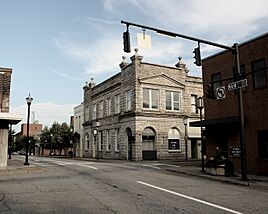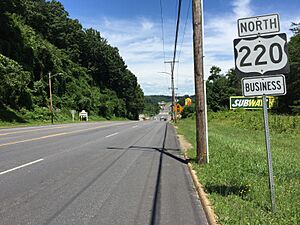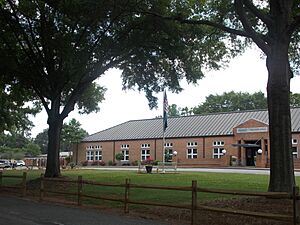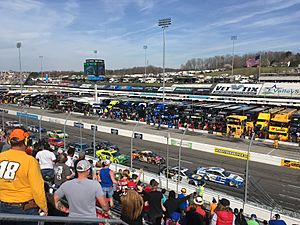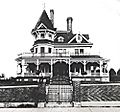Martinsville, Virginia facts for kids
Quick facts for kids
Martinsville, Virginia
|
||
|---|---|---|
|
Clockwise from top: Uptown Martinsville, Martinsville Speedway, Virginia Museum of Natural History, Piedmont Arts Association, Patrick & Henry Community College
|
||
|
||
| Nickname(s):
M-Ville, The 276, Titletown
|
||
| Motto(s):
A City Without Limits
|
||
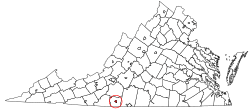 |
||
| Country | United States | |
| State | Virginia | |
| County | None (Independent city) | |
| Founded | 1791 | |
| Incorporated (town) | 1873 | |
| Incorporated (city) | 1929 | |
| Named for | Joseph Martin | |
| Government | ||
| • Type | Council-manager | |
| Area | ||
| • Total | 11.01 sq mi (28.51 km2) | |
| • Land | 10.96 sq mi (28.37 km2) | |
| • Water | 0.05 sq mi (0.14 km2) | |
| Elevation | 1,017 ft (310 m) | |
| Population
(2020)
|
||
| • Total | 13,485 | |
| • Density | 1,224.8/sq mi (472.99/km2) | |
| Time zone | UTC−5 (Eastern (EST)) | |
| • Summer (DST) | UTC−4 (EDT) | |
| ZIP codes |
24112-24115
|
|
| Area code(s) | 276 | |
| FIPS code | 51-49784 | |
| GNIS feature ID | 1498514 | |
| Website | http://www.martinsville-va.gov | |
Martinsville is a city in Virginia, United States. It is called an independent city because it is not part of a county. In 2020, about 13,485 people lived there. Martinsville is the main city in the Martinsville Micropolitan Statistical Area. This area includes nearby towns and has a population of about 63,765 people.
Martinsville is the main town for Henry County. However, the city and the county are separate. The Martinsville Speedway is a famous race track located near the city. It is the shortest track in the NASCAR Cup Series.
Contents
History of Martinsville
Martinsville was founded by American Revolutionary War General Joseph Martin in 1791. He had a large farm called Scuffle Hill near the Smith River. General Martin was friends with Patrick Henry, a famous American patriot. Henry County is named after Patrick Henry.
Important Events in the 20th Century
In 1941, a company called DuPont built a factory in Martinsville. This factory made nylon material. Nylon was very important during World War II. This factory helped the textile industry grow in the area.
The Martinsville Speedway opened in 1947. It is a unique oval-shaped track. NASCAR has used this track since 1949, and it is still used today. It is the shortest oval track in NASCAR.
For some years, Martinsville was known as the "Sweatshirt Capital of the World." In the 1980s, it was said to have many rich people for its size.
Local leaders worked to improve housing in the city. For example, Whitney Shumate helped rebuild homes in an area called "Mill Town." These new homes were better and had city services. This helped many middle-class Black residents buy homes and do well.
In the early 1990s, the textile and furniture factories in Martinsville faced challenges. Many companies closed, and thousands of people lost their jobs. This was because production moved to other countries. Now, the city is working to become a center for new technology and manufacturing.
Memorial Hospital of Martinsville opened in 1970. It replaced an older hospital called Martinsville General. Today, it is part of Sovah Health.
Martinsville in the 21st Century
In 2008, Barack Obama, who later became the 44th President of the United States, visited Martinsville during his campaign.
In 2013, Kim Adkins was re-elected as mayor. In 2021, Virginia Governor Ralph Northam pardoned seven African-American men known as the Martinsville Seven. In 2023, L.C. Jones was elected as the new mayor.
Martinsville and Henry County have a special relationship. Martinsville became an independent city in 1928. This means it is separate from Henry County. Even though Martinsville is the official county seat, many county offices are in Collinsville. In 2019, the city council thought about becoming a town again, which would make it part of the county. However, in 2023, they decided to stop this process.
Several historic places in Martinsville are listed on the National Register of Historic Places. These include the Beaver Creek Plantation and the Martinsville Historic District.
City Geography
Martinsville covers about 11 square miles (28.5 square kilometers). Most of this area is land. The city is located in southern Virginia, close to the North Carolina border. It is about 17 miles (27 km) northwest of Eden, North Carolina.
Climate and Weather
| Climate data for Martinsville, Virginia (1991–2020 normals, extremes 1937–present) | |||||||||||||
|---|---|---|---|---|---|---|---|---|---|---|---|---|---|
| Month | Jan | Feb | Mar | Apr | May | Jun | Jul | Aug | Sep | Oct | Nov | Dec | Year |
| Record high °F (°C) | 79 (26) |
82 (28) |
89 (32) |
92 (33) |
101 (38) |
102 (39) |
104 (40) |
105 (41) |
101 (38) |
95 (35) |
86 (30) |
82 (28) |
105 (41) |
| Mean daily maximum °F (°C) | 48.4 (9.1) |
52.2 (11.2) |
60.3 (15.7) |
70.8 (21.6) |
77.7 (25.4) |
84.7 (29.3) |
88.0 (31.1) |
85.9 (29.9) |
79.8 (26.6) |
70.7 (21.5) |
60.3 (15.7) |
51.1 (10.6) |
69.2 (20.7) |
| Daily mean °F (°C) | 36.1 (2.3) |
38.9 (3.8) |
45.9 (7.7) |
55.6 (13.1) |
64.0 (17.8) |
72.0 (22.2) |
76.0 (24.4) |
74.2 (23.4) |
67.6 (19.8) |
56.7 (13.7) |
46.0 (7.8) |
38.7 (3.7) |
56.0 (13.3) |
| Mean daily minimum °F (°C) | 23.8 (−4.6) |
25.5 (−3.6) |
31.6 (−0.2) |
40.4 (4.7) |
50.3 (10.2) |
59.2 (15.1) |
64.0 (17.8) |
62.6 (17.0) |
55.5 (13.1) |
42.8 (6.0) |
31.7 (−0.2) |
26.3 (−3.2) |
42.8 (6.0) |
| Record low °F (°C) | −7 (−22) |
−7 (−22) |
−3 (−19) |
18 (−8) |
26 (−3) |
35 (2) |
43 (6) |
41 (5) |
30 (−1) |
14 (−10) |
5 (−15) |
−2 (−19) |
−7 (−22) |
| Average precipitation inches (mm) | 3.83 (97) |
3.04 (77) |
4.08 (104) |
3.60 (91) |
4.50 (114) |
4.41 (112) |
4.01 (102) |
4.17 (106) |
5.09 (129) |
3.57 (91) |
3.33 (85) |
3.72 (94) |
47.35 (1,203) |
| Average snowfall inches (cm) | 3.3 (8.4) |
2.4 (6.1) |
1.7 (4.3) |
0.0 (0.0) |
0.0 (0.0) |
0.0 (0.0) |
0.0 (0.0) |
0.0 (0.0) |
0.0 (0.0) |
0.0 (0.0) |
0.0 (0.0) |
2.0 (5.1) |
9.4 (24) |
| Average precipitation days (≥ 0.01 in) | 9.5 | 9.1 | 10.5 | 9.7 | 12.0 | 11.3 | 11.7 | 9.8 | 9.0 | 8.0 | 8.2 | 9.9 | 118.7 |
| Average snowy days (≥ 0.1 in) | 0.7 | 0.4 | 0.5 | 0.0 | 0.0 | 0.0 | 0.0 | 0.0 | 0.0 | 0.0 | 0.0 | 0.3 | 1.9 |
| Source: NOAA | |||||||||||||
Population and Demographics
| Historical population | |||
|---|---|---|---|
| Census | Pop. | %± | |
| 1880 | 289 | — | |
| 1900 | 2,384 | — | |
| 1910 | 3,368 | 41.3% | |
| 1920 | 4,075 | 21.0% | |
| 1930 | 7,705 | 89.1% | |
| 1940 | 10,080 | 30.8% | |
| 1950 | 17,251 | 71.1% | |
| 1960 | 18,798 | 9.0% | |
| 1970 | 19,653 | 4.5% | |
| 1980 | 18,149 | −7.7% | |
| 1990 | 16,162 | −10.9% | |
| 2000 | 15,416 | −4.6% | |
| 2010 | 13,821 | −10.3% | |
| 2020 | 13,485 | −2.4% | |
| U.S. Decennial Census 1790-1960 1900-1990 1990-2000 2010-2020 |
|||
2020 Census Data
| Race / Ethnicity | Pop 2010 | Pop 2020 | % 2010 | % 2020 |
|---|---|---|---|---|
| White alone (NH) | 6,707 | 5,732 | 48.53% | 42.51% |
| Black or African American alone (NH) | 6,191 | 6,043 | 44.79% | 44.81% |
| Native American or Alaska Native alone (NH) | 18 | 23 | 0.13% | 0.17% |
| Asian alone (NH) | 127 | 116 | 0.92% | 0.86% |
| Pacific Islander alone (NH) | 0 | 4 | 0.00% | 0.03% |
| Some Other Race alone (NH) | 10 | 46 | 0.07% | 0.34% |
| Mixed Race/Multi-Racial (NH) | 216 | 496 | 1.56% | 3.68% |
| Hispanic or Latino (any race) | 552 | 1,025 | 3.99% | 7.60% |
| Total | 13,821 | 13,485 | 100.00% | 100.00% |
Note: the US Census treats Hispanic/Latino as an ethnic category. This table excludes Latinos from the racial categories and assigns them to a separate category. Hispanics/Latinos can be of any race.
2010 Census Data
In 2010, Martinsville had 13,821 people living there. About 48% were White, and 45% were African American. Around 5.7% of the population was Hispanic or Latino.
The average age in Martinsville was 41 years old. About 22.6% of the people were under 18. The average household income was $27,441.
Martinsville Economy
For many years, Martinsville's main business was making chewing tobacco. The area was known as the "plug tobacco capital of the world." After the American Civil War, tobacco companies helped the local economy grow.
Later, furniture making became the city's main industry for about a century. Today, some furniture makers still work in the region.
The Liberty Fair Mall opened in 1989. In 2014, it was renamed the Village of Martinsville.
In 2021, VF Corporation, a company that makes clothes and shoes, announced it would expand in Martinsville. This will create 82 new jobs. Other companies like Georgia Pacific and Eastman Chemical Company also have locations in the area.
Transportation in Martinsville
Martinsville is connected by several important roads.
Major Roads
 I-73 (future highway)
I-73 (future highway) US 58
US 58 US 220
US 220 SR 57
SR 57 SR 87
SR 87 SR 108
SR 108 SR 174
SR 174 SR 457
SR 457
Public Transport
The Piedmont Area Regional Transit (PART) provides bus services in Martinsville and Henry County.
Airports Near Martinsville
Martinsville is served by two larger airports:
- Roanoke–Blacksburg Regional Airport (ROA) in Roanoke
- Piedmont Triad International Airport (GSO) in Greensboro, North Carolina
The Blue Ridge Airport is a smaller airport used for private planes. It is about 9 miles (14 km) outside the city.
Education in Martinsville
Martinsville City Public Schools serve the city. There are five public schools:
- Martinsville High School: For grades 9–12, with about 580 students.
- Martinsville Middle School: For grades 6–8, with about 430 students.
- Albert Harris Elementary School: For kindergarten through fifth grade, with about 490 students. It is named after Albert Harris, who helped African-American children get an education.
- Patrick Henry Elementary School: For kindergarten through fifth grade, with about 435 students. It is named after Patrick Henry.
- Clearview Early Childhood Center: For preschool students, with about 140 students.
The Piedmont Governor's School for Mathematics, Science, and Technology is a special school. It offers advanced courses for 11th and 12th graders.
Carlisle School is a private school in Martinsville for students from kindergarten to 12th grade.
For higher education, Martinsville has the New College Institute and Patrick & Henry Community College. Students can also take online courses from Old Dominion University through the community college.
Places of Worship
Martinsville has many churches and places of worship, including:
- First Baptist Church
- Broad Street Christian Church
- Christ Episcopal Church
- First Presbyterian Church
- Starling Avenue Baptist Church
- Temple Baptist Church
- CrossPoint Church
Arts and Culture
Martinsville has places to enjoy art and learn about nature:
- Piedmont Arts Association: This museum was started in 1961. It is connected with the Virginia Museum of Fine Arts.
- Virginia Museum of Natural History: This museum opened in 1984. It is connected with the Smithsonian Institution.
Events and Festivals
Martinsville hosts fun events throughout the year:
- Henry County Fair: An annual fair held in September at the Martinsville Speedway.
- Martinsville Uptown Oktoberfest: A family-friendly event in Uptown Martinsville with music, crafts, food, and activities for kids.
- Wine by the River Festival
- Rooster Walk Music & Arts Festival
- Martinsville Kiwanis Pancake Day: A fundraiser that helps provide scholarships for young people.
Sports in Martinsville
Martinsville is home to the Martinsville Mustangs. They are a college summer baseball team that plays at Hooker Field.
The Martinsville Speedway is a very important sports venue. It opened in 1947. The NASCAR Cup Series and NASCAR Xfinity Series hold two races there each year. The NASCAR Craftsman Truck Series also has one race there.
Notable People from Martinsville
Many well-known people have connections to Martinsville, including:
- Rabih Abdullah – A former National Football League player.
- Buddy Arrington – A former NASCAR driver.
- Thomas G. Burch – A politician who served in the US House of Representatives and US Senate.
- H. Clay Earles – The person who founded the Martinsville Speedway.
- Carl Hairston – A former National Football League player.
- Patrick Henry – A famous American patriot.
- Randy Hundley – A former Major League Baseball player.
- Todd Hundley – A former Major League Baseball player and 2-time All-star.
- Joseph Martin – An American Revolutionary War general and explorer.
- Thon Maker – An NBA basketball player.
- J. C. Martin – A former Major League Baseball player who won the 1969 World Series.
- Shawn Moore – A former National Football League and Canadian Football League player.
- Nancy Redd – An author and former Miss Virginia.
- "Sweet Lou" Whitaker – A Major League Baseball player and 1978 AL Rookie of the Year.
- Dennis L. Via – A former Commanding General of the United States Army Materiel Command.
Media in Martinsville
Print Media
- Martinsville Bulletin: This is Martinsville's daily newspaper.
Television Stations
Martinsville receives television channels from the Roanoke/Lynchburg area and the Greensboro/Winston-Salem/High Point area.
- WDBJ (CBS)
- WSLS (NBC)
- WSET (ABC)
- WFXR (Fox)
- WWCW (Fox)
- WZBJ (Independent)
- WPXR (ION)
Radio Stations
- WHEE 1370: A local radio station in Martinsville.
- WROV-FM 96.3: A commercial FM radio station.
Images for kids
-
General Joseph Martin (1740–1808).
See also
 In Spanish: Martinsville (Virginia) para niños
In Spanish: Martinsville (Virginia) para niños


